This dispatch appeared in S01 Episode 6, our two-part exploration of WeChat sticker packs, along with Lurk. Shitpost. Hustle. Repeat. by Krish Raghav. All images used with creator’s permission.
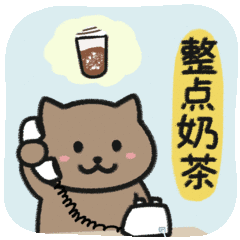
Yan: It’s very hard to describe why I like 一猫人 (YimaoRen, lit. “cat person”) so much—there’s this strange tendency in WeChat behaviour to champion an underdog (undercat?) sticker pack and make it “your own.” I’ve followed YimaoRen (on Weibo as well as WeChat) from very early on, and being witness to their growth and evolution feels a bit like being an aunt or a distant relative.
Krish: YimaoRen is cute in this precious way that feels so rare. There’s a purity to the expressions, a non-ironic wide-eyed wonder made somehow more adorable by the *just-slightly-too-slow* animation speed. It’s interesting, looking back at my sticker use, that I reserve certain characters for “true” ZQSG feelings rather than ironic reactions. YimaoRen was one of them.
Yan: I chatted with co-creator Maomao (猫猫) about the sticker’s pandemic origins, chaotic process, and McDonald’s collabs. This interview is translated from Chinese and edited for clarity.
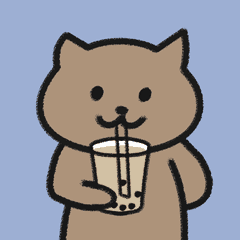
Yan: Hi! Could you introduce yourself?
Maomao (she/her): I’m the “main” creator of the 一猫人 character and sticker packs. I draw and come up with the concepts, and I collaborate with a former classmate—now a graphic designer—for the animations. He used to be called 大熊猫 (“Panda”), and I was 猫猫 (“MaoMao”), so our combined creator alt is 大熊猫本猫 (“PanDaCat”)
Yan: YimaoRen just celebrated its one-year anniversary! How did it all start?
Maomao: It came out of the pandemic at the beginning of last year. I moved back home to live with my parents in Shenzhen. There was a certain amount of pressure and anxiety, so I began to draw and paint by myself. I was not a trained illustrator, nor did I have any foundations in painting. I taught myself through Bilibili videos.
Back in college, I discovered I had a bit of talent for captioning funny pictures, and my meme “creations” were popular with classmates. I also helped a few friends come up with concepts for their WeChat stickers packs. Some of them were very well received.
Panda had gone back home too, during the pandemic. He was drawing stickers as well, and we’d riff on ideas. I’d just randomly drawn the YimaoRen character one day, and I sent it to Panda to take a look. There was this moment of mutual recognition—DENG! A lightbulb moment that this character could work as a protagonist.

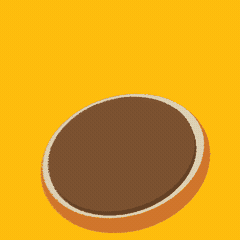
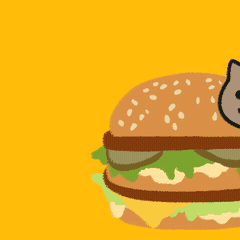
Yan: Can we talk about McDonald’s? In 2020, McDonald’s publicized an official collab sticker pack with YimaoRen. How did that happen?
Maomao: When things went down, YimaoRen had been going for around half a year. It didn’t seem like it was catching on that much, or doing great numbers. We’d just discussed changes and additions when the email dropped.
We were shook.
McDonald’s China was inviting us to cooperate with them directly. They’d seen our sticker pack, found it cute, and wanted to talk about an official collaboration. To be honest, I thought it was a scam at first. I mean, we had less than 300 Weibo followers. We were tiny, extremely niche. Even if they’d found us “cute,” it didn’t sound right. You’re McDonald's. I was also scrutinizing the email, like, shouldn’t McDonald's China be called Golden Arch Pvt Ltd?
(Note: McDonald’s China did officially change their name in 2017 to “Golden Arch” 金拱门—a move netizens mocked as unimaginatively literal, leading to memes like this:
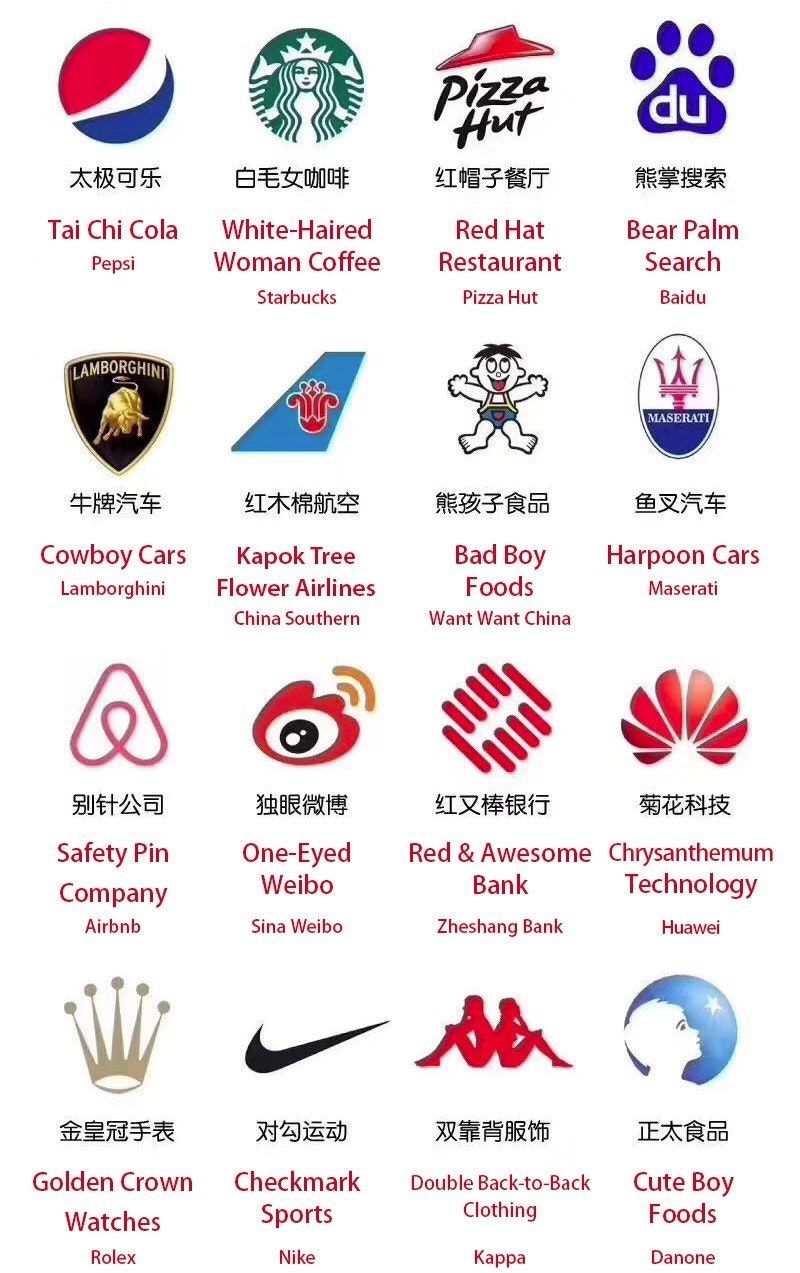
Long story short: it was not a scam.
McDonald's was a critical and important turning point in the YimaoRen story. We were close to calling it quits before it happened, thinking about finding new jobs, changing course.
They’d initially asked us for 3-5 stickers, and requested a timeline and quote. It was our first business deal of any kind, so we started by searching online for quotation templates. We weren’t that confident, so we quoted a very low price. The advice was, if you have McDonald's on your client list, that's enough. The endorsement mattered. If you lost money, so be it.
They agreed immediately to our offer. They didn't even read the details, just said OK, and let us ideate. Our advertising background served us well. We made a hilarious proposal document, and a lot of it was accepted.
There are pros and cons to this kind of brand collaboration. It doesn’t appear on our artist page, for instance. Many noticed McDonald's but didn't know who YimaoRen is, so it didn’t help us much in growing the fanbase. The real advantage is potential—when we talk to fat cats and top dogs in the future, we have a big golden arch on our resume. Most of all, it gave us hope that there was commercial value in what we were doing.
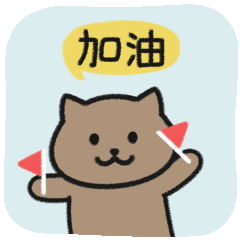

Yan: So what’s your process like? How do you come up with ideas for stickers?
Maomao: It’s a chaotic process. It’s like surfing the web and connecting A to B to C and suddenly everything makes sense. I take long baths. I’m the kind of person who, if I have five dreams in one night, will remember every single one. I write down ideas constantly.
Yan: That's amazing. Do your dreams ever become stickers?
Maomao: Maybe? My list is really long, and sometimes I never get to the good ideas. There are some truly strange things in my ideas document. I can read some out for you:
- “画画不积极,催更不积极” (“Slow to draw, slower to follow up”)—what kind of sticker can this be?
- I even wrote: “人间枯萎子,少女心注入” (“A dose of shoujo vibes, to bring the withered back to life”). Like, WTF?
- Also “青山不改,绿水长流” (“The mountains remain evergreen, and the waters everflowing”)…for some reason.
- Let’s see, what else...oh I like this one: “梦境是言灵的具象化” (“Dreams are the first draft of reality”). I wrote this a while ago but haven’t figured out how to represent it yet.
Yan: Do you think about “world-building” at all—is there a YimaoRen universe that you have plug ideas into?
Maomao: The world-building came much later. We established early that YimaoRen was a cartoonist, but we didn’t think about his personality or hobbies. All of that develops slowly as we create more scenarios and situations for YimaoRen.
Drawing the stickers is such an emotional investment, and you put so much of yourself into it that one day, I suddenly had this intense feeling that I had a son. That YimaoRen was like my child, one I’d imbued with dreams and hopes and yes, even my flaws. His world, in a way, is a reflection of my own—he does, on my behalf, what I want to do, what I can't, what I dare not. So we made this feeling a part of the world. On Mother’s Day, we “revealed” that our PanDaCat alt was, in fact, YimaoRen’s mom.

Yan: So YimaoRen is a...person? Not a cat.
Maomao: How can I explain this to you? Do you know Hello Kitty?
Hello Kitty is a little girl, you know?
Yan: Isn't Hello Kitty a cat?
Maomao: Hello Kitty is a little girl. A third grader from England.
Yan: My worldview is collapsing before my eyes.
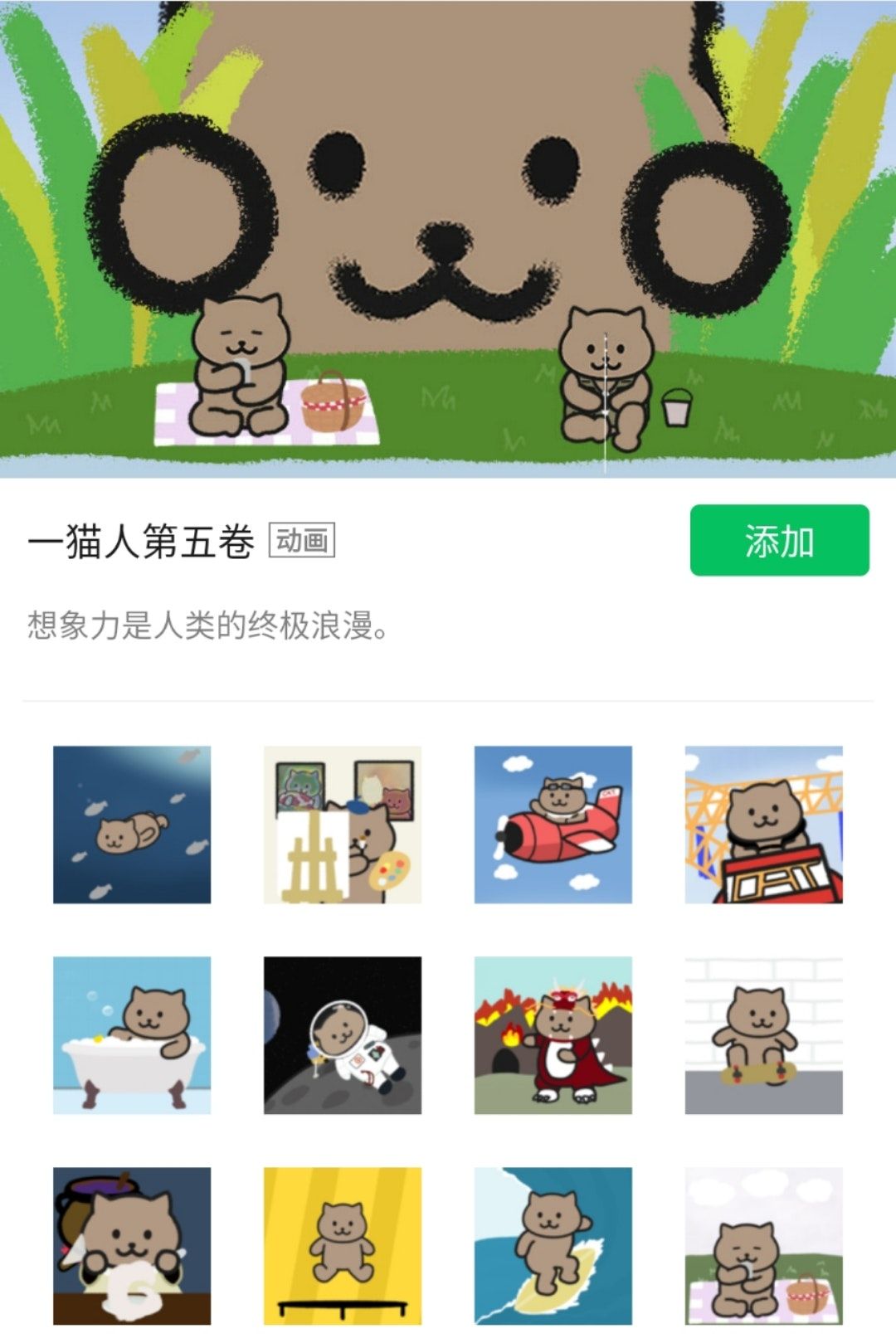
Yan: So how does a sticker pack come together from these disparate ideas? Maybe we can use the latest one as an example?
Maomao: This latest one was sparked by one sticker, which was a still image when I first painted it. I was really moved by it for some reason, it really sparked something. Panda didn’t get it. He just thought no one would use it.
I was fine with that, and when he asked what the theme of the pack would be, I said “天马行空”— “letting creativity run wild.” I had a lot of unused material that was discarded for being too “out there” and I brought it all together and packaged it for this one. It’s really special.
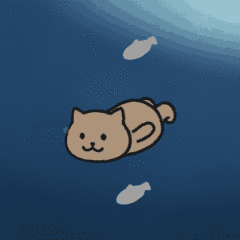
Yan: How’s the traffic data for this pack?
Maomao: It's very bleak.
Yan: How do you feel about that?
Maomao: I’ve made my peace with it. Making it made me happy, and this was the result I expected. I’m in it for the long-term, so I will continue to experience, observe, accumulate, mull and produce new content. I think sometimes you do feel powerless in the process, but it’s stimulating and the work keeps me going. It took me back to the pure joy of just wanting to paint well, and when YimaoRen can push me to expand my horizons, things like revenue or data become less important.
Yan: Can you be financially secure as a sticker maker?
Maomao: Impossible.
Almost all our revenue from the McDonald's collab was invested in copyright protection and trademark registration, and the cost is actually very huge. It’s a really sad situation for small creators in China. Everyone urges you to immediately secure copyrights as soon as your work gets even a little bit of exposure. The cost is prohibitive, but friends persisted: “Borrow money from your parents if you have to. If you’re successful and don’t do this early, you might find someone has claimed ownership first.
I was speechless. Many creators are really being cheated like this, by fraudulent copyright claims on their behalf. As a result, the original author “infringes” the rights of the pirates when they continue to use it, and the pirates can turn around and seize all your work. We’re still in the process of registering all our copyrights, but it’s a long journey.
Then there’s payment terms. There are so many examples online of creators drawing half or even 100% of a project before it’s called off, and you don’t get any money. You don't even have social security paid for you, and then you destroy yourself working for hundreds of hours.
On top of all that, income from WeChat stickers and red envelopes (Note: kind of like tip jars), for us, is quite low.
Yan: Do you think it's because people aren’t used to paying for this content?
Maomao: How do I say this? The vast majority of WeChat sticker users who are willing to pay are in China's second, third and fourth tier cities. Their aesthetic tends very differently—either big written characters, memes from TikTok, or “clip art-style” imagery. Our kind of work doesn't cater to that aesthetic. I’d rather not make money and continue to create the art I believe in.

Yan: It feels like the only way to survive as a sticker maker is to...well...commercialize an “IP” across platforms. Create products.
Maomao: You’re right. You can't support yourself only with stickers. We calculated it—you take the number of downloads and divide the number of paying “fans” and tips, and it’s shockingly low. And that’s just the number—most “tips” are less than 5 yuan.
For instance, the first sticker pack has been downloaded nearly 1 million times. It looks like a lot, but the return is very little. YimaoRen stickers have been sent in chats over 50 million times.
Yan: Do you have any plans for YimaoRen in the long run? You mentioned going back to finding a full-time job?
Maomao: I'm looking for one now, but haven’t found one yet. I’m looking for something a bit more leisurely than before. I used to be a professional minion. All my previous jobs were “007.”
Yan: So unsuited for a side-hobby.
Maomao: Yeah, and you really damage yourself and your mind. And recovering at home isn’t ideal, since there’s a different kind of pressure from your parents. When I’m job-searching, I think I might set a goal of “no 996, no 007,” and settle for a lower, but stable salary. My parents are really hard on me. They think I’m a squatter at home.
Yan: Tell me about your fan community on Weibo and WeChat.
Maomao: My fans on Weibo mostly comment or DM me to push me to release new sticker packs. I have a WeChat group of over 100 people. We’re like friends, talking about random things. Unlike on Weibo, my WeChat fans care about my well-being. They constantly check in on me—if I’ve had dinner on time, if I’ve stayed up too late. They even know that I really like to drink Iced Lemon Tea, and they drop links whenever there’s a sale.
My fans really like my daily updates outside the sticker packs, whether it’s an illustration, comic strip or short video. I told them it’s because both me and Panda are unemployed. What else can we do? When we’re not sleeping, we draw. That’s why we manage to update daily.
If I do get a full-time job, I can only prioritize creating new sticker packs. So I told my fans to cherish this time. When both of us are jobless.
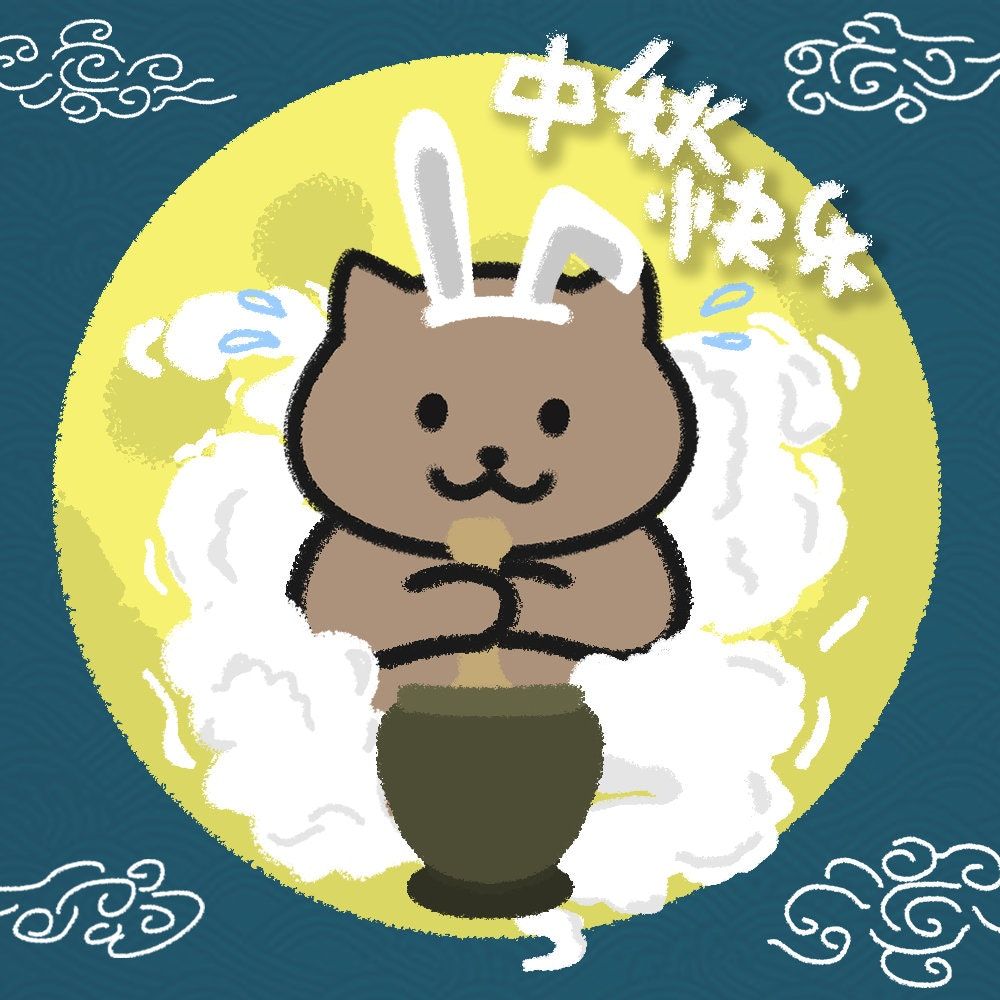
Aaron: It's interesting if unsurprising that both Jiang ZhiShu and Maomao mention Japanese culture or Hello Kitty, since it seems like a lot of WeChat sticker IP has learned lessons from Japanese mascot design, and the way those mascots fill a need for anesthetic expression. Gudetama, a “sad egg yolk crippled by existential despair”, is an especially good example of this, like in this interview with Matt Alt or the head designer. The whole thing feels to me like something that's rapidly moving from "wacky Asian phenomenon" to "standard method of communication" in Western eyes.
Jaime: I want to suggest we can even trace a lineage of sticker communication further back to the iconography and visual communication systems in Chinese decorative art and print history. Certain self-contained narrative universes and protagonists of sticker packs lend themselves as essentially deconstructed versions of woodblock new year’s picture (年画, nianhua)—literal sticker-posters that people used to put up on their walls and doors for vibes.
These locally mass-circulated woodblock prints, under various schools and aesthetic subgenres, can be epic group portraits that are essentially “positive energy” mood boards, FILLED with internal drama, featuring sets of symbolic characters and illustrating relatable content drawing from scenes of daily life, traditions, current events (i.e. village gossip), to nature worship and spiritual aspirations—not so unlike the ethos in today’s sticker packs. Another interesting parallel is as folk art, new year picture makers were also often anonymous and considered lower-rung than their “fine arts” counterparts.
Character-, reaction-, and coping mechanism-driven sticker packs like YimaoRen and Fuyan-kuma also make me think of the iconography of kungfu manuals in wuxia traditions—if we consider the context and narrative of each pose in a series of moves being contained within one icon of illustration, captioned by a poetic or meme-able title. And speaking of poetic agency in mass communication, let’s not forget graphic design was Lu Xun's passion.
If you haven’t, consider subscribing to Chaoyang Trap, a newsletter about everyday life on the Chinese internet. It’s a regular, usually fortnightly, exploration of contemporary China, one important niche at a time. We’re interested in marginal subcultures, tiny obsessions, and unexpected connections.
Paid subscribers get access to our special deep-dives and premium issues!
Yan Cong is a Beijing-based photographer, and one of the founders of Far & Near, a Substack about visual storytelling in China. You should subscribe!
Maomao is a sticker maker based in Shenzhen. 一猫人 is on Twitter. Please follow 一猫人.
Krish Raghav is a comic-book artist in Beijing who has one-too-many 我很好 stickers.
Aaron Fox-Lerner is a writer, editor and game designer based in Beijing. He has his own sticker:
Jaime (bot) is a critic and translator in Beijing who works in Chaoyang and is moving to Chaoyang. She is also a contributing editor at Spike.

